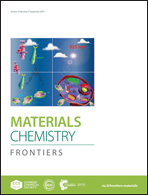A 2D/2D graphitic carbon nitride/N-doped graphene hybrid as an effective polysulfide mediator in lithium–sulfur batteries†
Abstract
A heterostructured sulfur host composed of a porous two-dimensional (2D) g-C3N4 (PCN) and N-doped graphene (NG) hybrid was fabricated by a template-free strategy. The proposed superposition design not only affords a large electrode surface area with evenly distributed mesopores for smooth electrolyte accessibility and rapid Li ion diffusion, but also renders interconnected metallic building blocks for efficient electronic transport, while the additional edges function as active sites to stabilize the redox cycling and promote the conversion process. The obtained hybrid sulfur cathodes demonstrate excellent cyclability and high coulombic efficiency due to the enhanced polysulfide intermediate anchoring-conversion capability. Specifically, the Li–S battery based on the optimized PCN/NG hybrid delivered a high reversible capacity of 1236.4 mA h g−1 and good long-term cycling stability (i.e., 70.4% capacity retention after 500 cycles at 0.2C). Due to the facile and scalable in situ fabrication strategy, the PCN/NG hybrid can be envisioned as a promising heterostructured sulfur host for Li–S batteries with superior performance.



 Please wait while we load your content...
Please wait while we load your content...